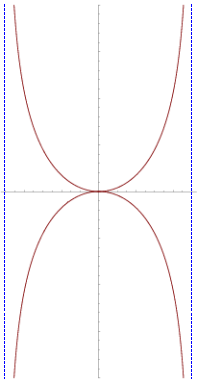Kappa curve
From Wikipedia, the free encyclopedia
From Wikipedia, the free encyclopedia
In geometry, the kappa curve or Gutschoven's curve is a two-dimensional algebraic curve resembling the Greek letter ϰ (kappa). The kappa curve was first studied by Gérard van Gutschoven around 1662. In the history of mathematics, it is remembered as one of the first examples of Isaac Barrow's application of rudimentary calculus methods to determine the tangent of a curve. Isaac Newton and Johann Bernoulli continued the studies of this curve subsequently.

Using the Cartesian coordinate system it can be expressed as
or, using parametric equations,
In polar coordinates its equation is even simpler:
It has two vertical asymptotes at x = ±a, shown as dashed blue lines in the figure at right.
The kappa curve's curvature:
Tangential angle:
The tangent lines of the kappa curve can also be determined geometrically using differentials and the elementary rules of infinitesimal arithmetic. Suppose x and y are variables, while a is taken to be a constant. From the definition of the kappa curve,
Now, an infinitesimal change in our location must also change the value of the left hand side, so
Distributing the differential and applying appropriate rules,
If we use the modern concept of a functional relationship y(x) and apply implicit differentiation, the slope of a tangent line to the kappa curve at a point (x,y) is:
Seamless Wikipedia browsing. On steroids.
Every time you click a link to Wikipedia, Wiktionary or Wikiquote in your browser's search results, it will show the modern Wikiwand interface.
Wikiwand extension is a five stars, simple, with minimum permission required to keep your browsing private, safe and transparent.